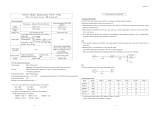
Contents
ix
4.1.14 Cumulative power monitoring (d015, b078, b079) ······················································4 - 4
4.1.15 Cumulative operation RUN time monitoring (d016)·····················································4 - 4
4.1.16 Cumulative power-on time monitoring (d017) ·····························································4 - 4
4.1.17 Heat sink temperature monitoring (d018)····································································4 - 4
4.1.18 Motor temperature monitoring (d019, b98)··································································4 - 4
4.1.19 Life-check monitoring (d022)·······················································································4 - 5
4.1.20 Program counter display (easy sequence function) (d023)·········································4 - 5
4.1.21 Program number monitoring (easy sequence function) (d024)···································4 - 5
4.1.22 User monitors 0 to 2 (easy sequence function) (d025 to d027) ··································4 - 5
4.1.23 Pulse counter monitor (d028) ······················································································4 - 5
4.1.24 Position command monitor (in absolute position control mode) (d029)······················4 - 5
4.1.25 Current position monitor (in absolute position control mode) (d030) ··························4 - 5
4.1.26 Trip Counter (d080)······································································································4 - 5
4.1.27 Trip monitoring 1 to 6 (d081, d082 to d086)································································4 - 6
4.1.28 Programming error monitoring (d090)·········································································4 - 6
4.1.29 DC voltage monitoring (d102)······················································································4 - 6
4.1.30 BRD load factor monitoring (d103, b090)····································································4 - 6
4.1.31 Electronic thermal overload monitoring (d104)····························································4 - 6
4.2 Function Mode··························································································································4 - 7
4.2.1 Output frequency setting (F001, A001, A020/ A220/ A320,C001 to C008) ·················4 - 7
4.2.2 Keypad Run key routing (F004)···················································································4 - 7
4.2.3 Rotational direction restriction (b035)··········································································4 - 7
4.2.4 Frequency source setting (A001) ················································································4 - 8
4.2.5 Run command source setting (A002, C011 to C018, C019, F004)·····························4 - 8
4.2.6 Stop mode selection (b091, F003, b003, b007, b088) ················································4 - 9
4.2.7 STOP key enable (b087) ·····························································································4 - 9
4.2.8 Acceleration/deceleration time setting (F002, F003, A004, P031, C001 to C008)······4 - 10
4.2.9 Base frequency setting (A003/ A203/ A303, A081, A082)···········································4 - 11
4.2.10 Maximum frequency setting (A004/ A204/ A304) ························································4 - 11
4.2.11 External analog input setting (O, O2, and OI) (A005, A006, C001 to C008)···············4 - 12
4.2.12 Frequency operation function (A141 to A143, A001, A076) ········································4 - 13
4.2.13 Frequency addition function (A145, A046, C001 to C008)··········································4 - 14
4.2.14 Start/end frequency setting for external analog input (A011 to A015, A101 to A105,
A111 to A114)···············································································································4 - 14
4.2.15 External analog input (O/OI/O2) filter setting (A016)···················································4 - 15
4.2.16 V/f gain setting (A045, A082)·······················································································4 - 15
4.2.17 V/F characteristic curve selection (A044, b100, b101)················································4 - 16
4.2.18 Torque boost setting (A041, A042, A043, H003, H004)···············································4 - 18
4.2.19 DC braking (DB) setting (A051 to A059, C001 to C008)·············································4 - 20
4.2.20 Frequency upper limit setting (A061, A062) ································································4 - 24
4.2.21 Jump frequency function (A063 to A068) ····································································4 - 25
4.2.22 Acceleration stop frequency setting (A069, A070, A097)············································4 - 25
4.2.23 PID function (A001, A005, A071 to A076, d004, C001 to C008, C021 to C025,
C044)···························································································································4 - 26
4.2.24 Two-stage acceleration/deceleration function (2CH) (F002, F003, A092 to A096,
C001 to C008) ·············································································································4 - 30
4.2.25 Acceleration/deceleration curve selection (A097, A098, A131, A132) ························4 - 31
4.2.26 Energy-saver operation (A085, A086)·········································································4 - 32
4.2.27 Retry or trip after instantaneous power failure (b001 to b005, b007, b008,
C021 to C026) ·············································································································4 - 33
4.2.28 Phase loss power input protection (b006)···································································4 - 36
4.2.29 Electronic thermal protection (b012, b013, b015, b016, C021 to C026, C061) ··········4 - 37






















